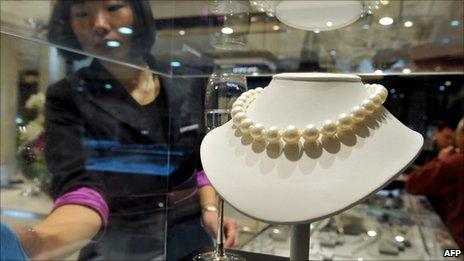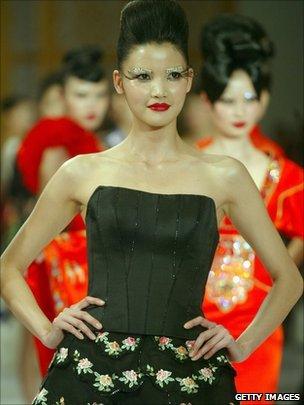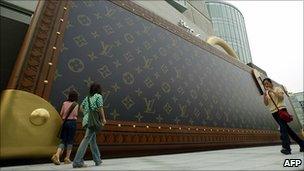Asian shoppers thirst for luxury
- Published

Conspicuous consumption is catching on amongst China's newly wealthy
Something quite extraordinary is happening across Asia.
In the big cities all across the continent, people are shopping as though their lives depended on it, day after day.
In Singapore and Hong Kong, it's been the main leisure pursuit for years.
But now, rather suddenly, the cult of luxury shopping is spreading - and China is emerging as what will soon be the biggest luxury market in the whole world.
Eclipsed
So many times in the past few decades, the insatiable appetite of the Americans for imported consumer goods has helped the world out of recession or helped to avoid it.
But if China's emerging class of consumers put their mind to it - up to 800 million of them, compared with roughly 200 million in the USA - their buying power will shape the needs and demands of the rest of the world.
In 2010 China became the biggest marketplace in the world for cars. It was already the largest market for mobile phones. The world's second largest economy, Japan, has been deposed - replaced (of course) by China.
And the place that has hitherto been the great consuming nation - the USA - is soon going to be eclipsed. Asians seem to have an even hungrier appetite for luxuries: people who only 20 years ago hardly knew what bling was.
Status symbols
Retail expert Paul Husband has been based in Hong Kong for 25 years and he knows the scale of what's happening in the East.
And with his Louis Vuitton bag, Cartier watch and Ferragamo shoes, he knows a thing or two about luxury too.
"It began really in the very late 80s and early 90s," he says, when the first luxury brands like Dunhill began to enter China.
These pioneers tended to base themselves in and around western hotels - although their customers were not always westerners.
"It was opening the cult of luxury. At that time of course, you would see them in hotels and not on the street because the people with money - well, quite frankly one might have questioned where the money had come from. They had to be very discreet. Hence the luxury stores also had to be fairly invisible to the street. One didn't want to be seen going in."
But thirty years later attitudes are different. China has a more relaxed attitude toward wealth and many Chinese have successfully followed Deng Xiaoping's maxim that "to be rich is glorious".
Rags to riches

Beijing's Fashion Week features the work of Chinese designers like NE Tiger
The workshop of Chinese fashion designer Zhang Zhifeng in the posh centre of Beijing is a vivid example of the opportunities open to an entrepreneur in a China moving quickly from communist puritanism to Western-style consumerism.
The ambitious but approachable designer, who heads up the label Tiger NE, is one of the people in China trying to create expensive luxury brands that speak directly to this booming market of people with newly acquired wealth.
His own story is a peculiarly Chinese take on the rags to riches tale.
"At the time of the cultural revolution, my dad was labelled as a capitalist and thrown into a gulag-style labour farm," says Mr Zhang.
"Our family was dirt poor. My mum had to learn tailoring just to make a living, to feed the family."
Mr Zhang learned the craft too, and after graduating from high school he opened his own small shop - just him and a sewing machine.
"This was in 1982. This was still the early days of China's reform and opening up."
When the government began to allow cross-border bartering, Mr Zhang's position on the Sino-Russian border meant he was able to take advantage of one of the first market liberalisations.
"Because of the barter trade, my business started to take off," he says. "Family and friends joined in to help as more and more business came my way. Soon, in 1985, my shop hired more than 300 employees."
"I was one of the first Chinese who had the opportunity to go abroad," says Mr Zhang, who visited his trading partners in the former Soviet Union, and, eventually, Europe and America.
'All we had was quantity'
"The more I saw, the more I realised what the differences were between the Chinese and Western clothing industries. For example, the cost of making a shirt in China was about 20 Yuan and the shirt retailed for about 30. But in the States and Europe, a shirt can often fetch anywhere from US $30 to about $100."

Western luxury brands have now arrived in China in a big way
In the West, the brand and the design quality had all been factored into the price, he realised, "but all we had in China was quantity. That was when I decided to improve and move into the high end fashion business."
NE Tiger was registered as a brand in 1992. At the time, a Chinese-owned and run luxury brand was highly unusual - and remains so today according to Zhang Zhifeng.
"In Beijing and Shanghai, our shops are still mainly surrounded by Western brand shops," he says.
"The only Chinese high end brand is mine. We are soon to launch a flagship store in Shanghai central shopping district where my new neighbours will be the likes of Louis Vuitton."
Expanding
This puts Mr Zhang is in a good position to take advantage of Asia's luxury boom, according to Paul Husbands.
"There's a view that by 2014/15, China will be the largest luxury goods market in the world, meaning that consumption in China and consumption offshore by mainland Chinese would outperform Japan, America and Europe," says the retail expert.
"It's the one large market in the world where we cannot see really an end to the market."
The rise in demand for luxury goods is not just confined to China - it is happening across Asia.
For the series Start-up Stories, I have been speaking to entrepreneurs across the continent, some of whom are looking for a slice of this expanding market.
I've heard from Ho Kwon Ping, whose luxury resort chain Banyan Tree is now exporting an Asian take on luxury to the rest of the world. And I've spoken to watch retailer Jannie Tay and chocolatier Lyn Lee, whose businesses started in Singapore but now trade across Asia.
There are bound to be many more of these stories to come. The arrival of a mass of Asian consumers is quite extraordinary. It's potentially much more significant for the global economy than the 30 year emergence of China as the world's great manufacturing centre.
As we're about to see, when people start to become consumers, what they want is a little bit of luxury.